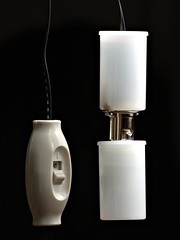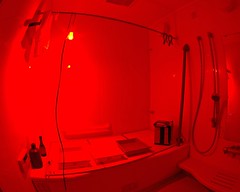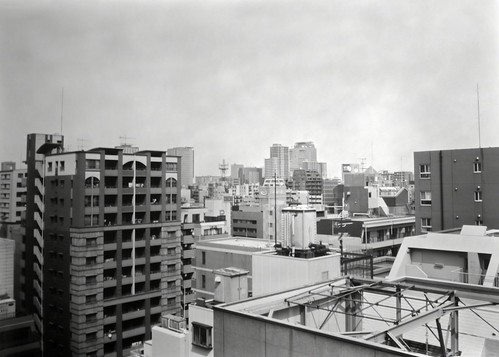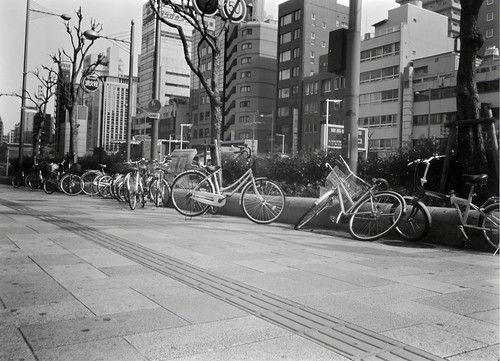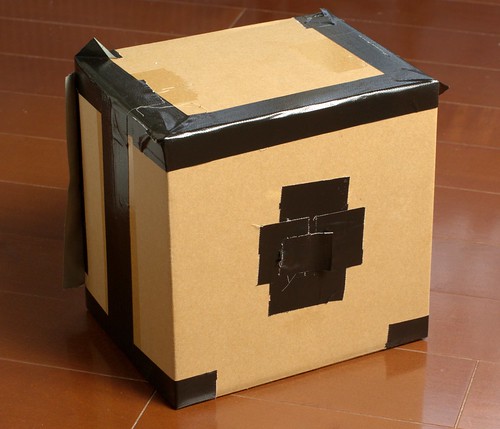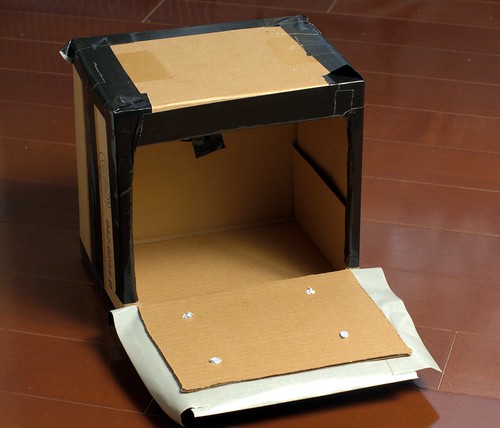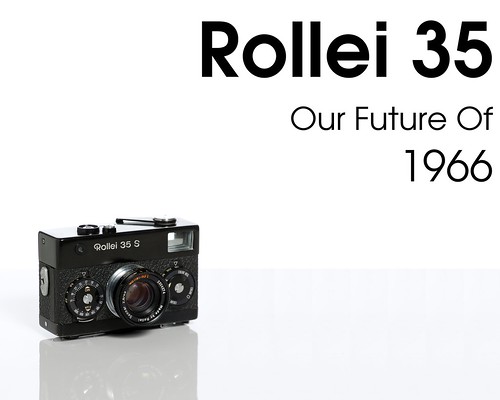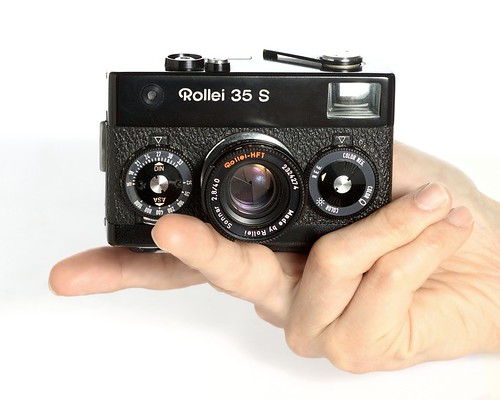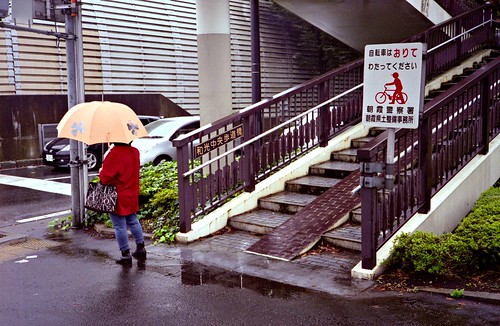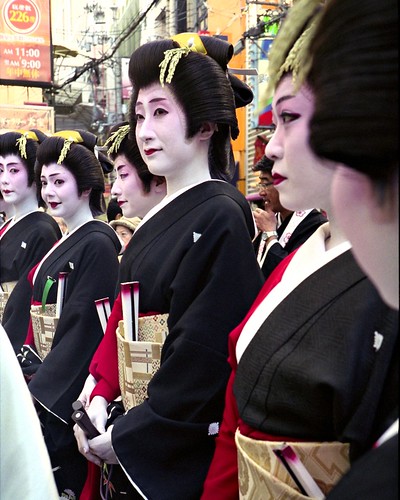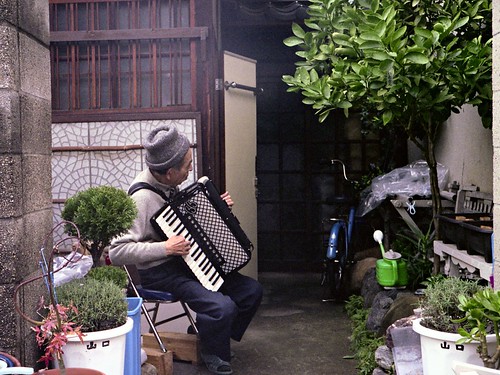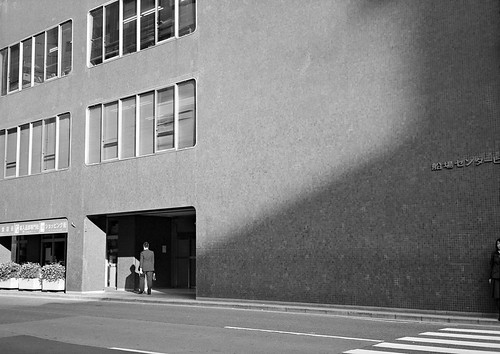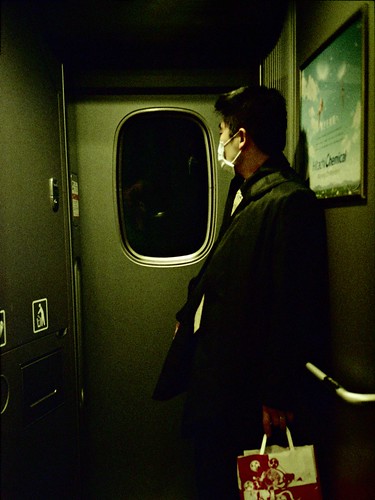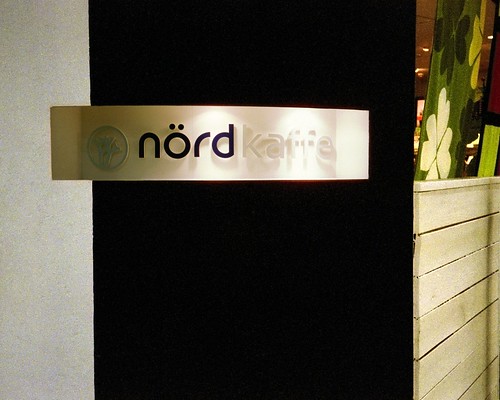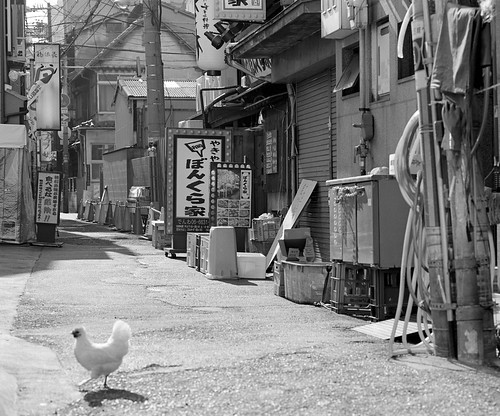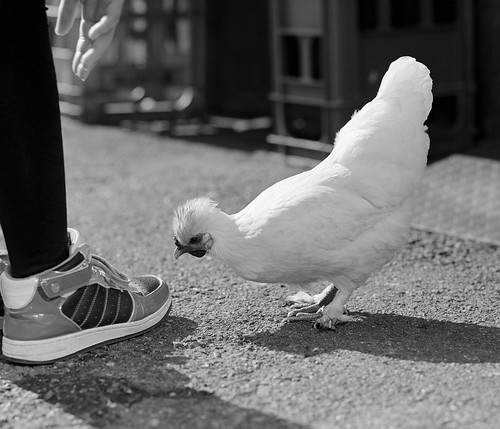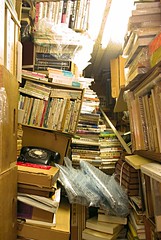I wrote, oh, half a year ago about my experience with a
disposable film camera. The Fuji camera was really small, light and fun to use. It had a cheap plastic lens, no way to focus and no way to adjust for the light but the results were still surprisingly good. I got the idea that I should try to find a small, manual film camera like that, only with a bit more flexibility and better build. An always-there camera I could keep in my coat pocket. I found this:
There's a
lot of compact film cameras out there. You may think there's a lot of compact digital cameras to choose from today, but camera companies have been churning out compact cameras for as long as photography has existed; of course, what consitutes "compact" has changed over time. There's entire books cataloguing just compacts from a specific company, or from one era, or compacts with some technical feature in common. Most models aren't all that interesting, just cookie-cutter variations on the dominant designs of their era, and they've long since faded into obscurity. But some cameras do stand out.
The Rollei 35 S. Pictures don't really convey just how small and compact this camera is.
The Rollei 35 appeared in 1966 and was the smallest 35mm camera ever at the time. It's still the smallest ever all-mechanical 35mm camera. As you can see above, it's quite literally built like a metal brick: a rectangular slab with controls that only barely stick out from the flat surfaces. The flat, circular knobs on the front set the aperture and shutter speed. The winding lever, lens lock and shutter button on the top, and hot shoe and rewind lever on the bottom are all almost flush with the surface. The lens retracts into the body when it's not being used. The small size and flat surfaces means you can even carry it comfortably in your front jeans pocket.
Rainy day in Wako city. This is the kind of shot that's difficult to get with a large camera. You have very little time, and the rain means you don't want to drop your umbrella and start messing about with a big DSLR, and get all wet, and probably miss the opportunity anyway.
Of course, this design has a few drawbacks. While small, the all-metal build is fairly heavy - it really
feels like a small metal brick. And the flat rectangular design makes for some interesting ergonomics. The front wheels have small, hard-to-see markings along the edge (the front-facing labels are just there to help you remember the film you use). The film advance lever is on the left, rather than right - fine by me, but then, I'm left-handed. There's no grip or handle or place to keep your hands.
The hot shoe is on the
bottom of the camera, right next to the tripod mount and the frame counter. You'll not be using a flash and a tripod at the same time. Or use a tripod and see how many frames you've shot. Or change the film while on a tripod. And a flash will either light your subject from below, for that spooky flashlight-under-your-chin look; or you hold the camera upside down and trigger the shot with your left little finger. But this is not a tripod or flash-kind of camera, so these are amusing oddities rather than real drawbacks.
The mechanics inside are a marvel of ingenuity, but they add to the quirkiness. The shutter mechanism is designed in two separate parts, one in the camera house, and one in the lens itself. The lens can only be folded in with the shutter cocked, and in fact the camera is designed to be stored with a wound-up shutter. My camera has probably been stored like that more or less constantly since it was manufactured in the 1970's, but the shutter still works fine at all speeds. As you need to wind the film to fold in the lens you can't just close it after taking the last frame as the film won't wind any further. You need to rewind the film right after the last shot; another small quirk.
Yebisu parade in Namba, Osaka. Grainy film, slow shutter speed and just wildly guessing the focus distance. Pictures don't need to be technically perfect to be good images.
This is a guess-focusing camera, like the old
Voigtländer Bessa I have. No rangefinder of focusing screen in other words, just a scale on the lens telling you the distance. There's a battery driven light meter that is always turned on - you turn it "off" simply by covering the meter cell. It seems to work well, overall, but my camera has a slow current leak so the battery drains after a couple of weeks. No matter, as I always use an external meter anyhow.
A rectangular, odd film camera with fiddly collapsible lens, no focusing and strange control layout. Sounds horrible, I know, but it's a very pleasant camera to use in practice. First, this is not meant to be an all-in-one camera. It's not going to be used in a studio, it's not going to be used for huge, high-quality prints or slow, contemplative photography - there's better cameras for that. This camera is meant to slip into your pocket and simply be there whenever you feel like taking a quick snapshot of something. And in that role, it absolutely excels.
An old man is practicing outside his home in Nishitanabe, Osaka. On my way to my Japanese lesson and I had a bagful of books. Without a pocket camera I'd not have any way of getting this. And the film defects - the grain, the odd color balance - add to the image, I think.
The lens is a high-quality 40mm f/2.8. The focal length is fairly short, and you're not going to make huge prints from the camera anyway, so focusing is usually a non-problem. In daylight with a 400 iso film you can simply set the camera to f/11, set the distance to 4-5 meters or so and forget about it. Everything you need will be in focus. When it's dark you have to open up the lens so you'll need to start thinking about focus, but again, it's not hard. We're not bad at guessing distances, and we can quickly get better if we practice a bit. And getting focus right really only matters close up and with near-open aperture. If you shoot at around 1-1.5 meters at f/2.8 you'll better take two shots just in case. Any other time you'll most likely get it right without even trying.
Black and white is fun too, of course. But this camera came at the time color film was becoming a mass photographic medium, and at a time - the 1970's - when color exploded in media, in design and in fashion. This camera
likes color film.
And despite the unforgiving shape and small size it really lies well in your hands. Everything is nearly flush with the body so you can easily cradle the whole camera in the hand without accidentally changing some setting or pressing something. The viewfinder is bright and clear and all the controls feel snappy and distinct. Loading the film is easy when you've done it once, and the small format means you can squeeze a few extra frames from the film; I get 27 or 28 shots on a 24-shot roll (the very first possible shot is just a little cut off).
Salaryman on his way home on the Tokyo-Osaka Shinkansen. This is about as bad as conditions will ever get: dim light that demands an open aperture and a slow shutter; flourescent lamps to mess up your color balance; fast-moving train shaking you and your subject; short focal distance and no time to steady yourself to catch that weary, resigned posture before he becomes self-concious about it and you lose the moment.
Using the Rollei 35 means guess-focusing, flare-prone (though good quality) lens, fast film, cheap scanner and - quite often - slow shutter speeds. And as the camera encourages a breezy the-devil-may-care attitude to using tripods or stable handholding, the resulting pictures aren't all that high resolution. The shots I normally get are, in practice, oh, 4-6 megapixels or so. Use a high-resolution film, put the camera on a tripod and measure the actual distance and you can probably get upwards of 10mp, and more than that with a high-quality scanner. But why would I? If I want high resolution I already have other cameras for that. And I enjoy the pictures I get all the more for their grain, slightly off color and motion blur.
In fact, apart from the weight this is very nearly exactly what I was looking for when I wrote about the reusable Fuji camera last year: a tiny, fun wide-angle point and shoot, but with better optics and some way to set focus, aperture and shutter speed. I got all that, and a camera that oozes precision engineering out of every pore (being a Rollei, it of course oozes it in a predictable, reliable, perfectly controlled manner).
Standing bar in Ikebukuro. For whatever reason, people seem much less self-concious about film cameras than digital ones. A digital camera is a nuisance, or even threatening. A film camera is amusing and a little quaint.
A few tips for use:
- To wind the film you close the cover, pull out the lens and shoot-wind-shoot-wind... until you get to frame '1'. However, in practice the first "real" frame is two frames before '1', so you may want to make use of that.
- Remember, the lens needs to be pulled out, then twisted to lock. Nothing happens if you forget this. And you can't unlock and retract the lens until you wind the film. If you shot the last frame you can't wind the film any longer, so you need to wind back the roll before you can close the camera.
- Make sure you don't hold your finger on the shutter as you wind the film; it can accidentally disengage the winding mechanism, so you end up taking a double exposure. Unfortunately, this doesn't seem to be reliably repeatable (and I'm not sure it's good for the mechanism) so you can't really use it on purpose either.
- The lens is prone to flare. A hood is a good idea. I got a Rollei collapsible rubber hood with my camera that fits perfectly.
- The shutter button is not a trigger. It actually holds the shutter open, while the shutter timer is a trigger that closes the shutter again. So if you release the shutter button before the exposure is done you'll close the shutter too early and get an underexposed picture. Keep the finer on the shutter until you're done, in other words.
- There's no visual indication when you have rewound the roll. Make sure you've really rewound the whle thing before you open the camera. I lost part of my first roll when I opened it halfway.
Would I use this as my main camera? Nope. It's too limited - though what it does do, it does well. Would I recommend it as a beginner's film camera? Umm, no. It's a bit too weird and unforgiving. But I can happily recommend it for those who like using film, who like street photography and who want a tiny camera to take along for those chance opportunities that keep showing up if only you look for them.
Kita Ikoma station, Nara.

